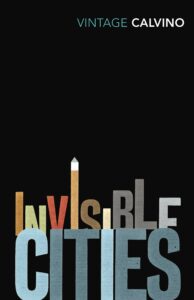I read Invisible Cities ages ago when I worked for a bookstore in Atlanta and was reading more consciously literary things. I picked it up again recently thanks to a Twitter thread. Jo Walton had been doing a series of 50 manipulated images of Venice. As she wrote, “In honour of Italo Calvino’s Le Citta Invisibile, which is visions of fifty cities [there are 55, actually] that are all Venice, I’m going to post a different version of this photo every day.” David M. Perry, a journalist and historian, chimed in with
Kublai: Why don’t you talk about Venice, Marco
Polo: I’ve been talking about Venice the whole time… is a moment that shapes my whole approach to medieval urban history.
He added, “Novel pitch: Invisible Cities but with more wizard shit.” Ada Palmer, no stranger to big ideas in literature, was succinct in her enthusiasm: “Sold!” Hello, writing prompt. In the meantime, I have read the book again.
Invisible Cities was published in Italian in 1972 and in English in 1974. The conceit of the book is that Marco Polo is describing to Kublai Khan cities within the Khan’s empire that Polo has visited. The Khan knows that his empire is too vast for him to apprehend it all himself; therefore, he relies on messengers to bring him reports from across his lands, telling him what he needs to know but cannot discover on his own. “Kublai Khan does not necessarily believe everything Marco Polo says when he describes the cities visited on his expeditions, but the emperor of the Tartars does continue listening to the young Venetian with greater attention and curiosity than he shows any other messenger or explorer of his.” (Ch. 1) Following the framing introduction are Polo’s reports of cities within the Khan’s realm, or at least that is how they appear initially.
In the first chapter, there are ten such reports. Each city is named and discussed, and each is also placed within a thematic group such as the four from the first chapter: “Cities & Memory,” “Cities & Desire,” “Cities & Signs,” and “Thin Cities.” There are eleven groups, and each group appears five times, for a total of 55 cities described within the book. These are occasionally punctuated by direct conversations between Polo and Kublai Khan. The themes follow a strict mathematical progression within the book, giving the whole a structure that is at once rigid and playful. Readers may progress through the book as written, or they may follow one of the thematic threads; they could easily read Invisible Cities in a different order altogether.
There is not a plot, as such. Each of the descriptions is self-contained, and some of them are almost short enough to be epigrams. Impressions add up over time, and as the book progresses both the descriptions and the interstitial dialogues wander farther from the literal idea of Marco Polo and Kublai Khan conversing in the 1200s. At times, Kublai recalls Polo describing cities of the empire before they shared a common language; he says Polo communicated entirely through gestures and artfully arranged objects. He speculates that he understood Polo more clearly in those days. At other times, they trade barbs on the nature of cities, or perhaps on the nature of communicating.
Kublai Khan had noticed that Marco Polo’s cities resembled one another, as if the passage from one to another involved not a journey but a change of elements. Now, from each city Marco described to him, the Great Khan’s mind set out on its own, and after dismantling the city piece by piece, he reconstructed it in other ways, substituting components, shifting them, inverting them.
Marco, meanwhile, continued reporting his journey, but the emperor was no longer listening.
Kublai interrupted him: From now on I shall describe the cities and you will tell me if they exist as I have conceived them. I shall begin by asking you about a city of stairs, exposed to the sirocco, on a half-moon bay. Now I shall list some of the wonders it contains: …
“Sire, your mind has been wandering. This is precisely the city I was telling you about when you interrupted me.”
“You know it? Where is it? What is its name?”
“It has neither name nor place. I shall repeat the reason why I was describing it to you: from the number of imaginable cities we must exclude those whose elements are assembled without a connecting thread, an inner rule, a perspective, a discourse. With cities, it is as with dreams: everything imaginable can be dreamed, but even the most unexpected dream is a rebus that conceals a desire or, its reverse, a fear. Cities, like dreams, are made of desires and fears, even if the thread of their discourse is secret, their rules are absurd, their perspectives deceitful, and everything conceals something else.” (Ch. 3)
The cities themselves go through similar permutations. Anachronisms abound, but each has a coherent character, and many of the descriptions raise questions about meaning, intent, and causation. Invisible Cities is not so much a novel as a series of games, an open-ended provocation, and a set of meditations about words, people, civilization and meaning. All of the cities may indeed be Venice, but they are also every other city, invisible within the visible.

